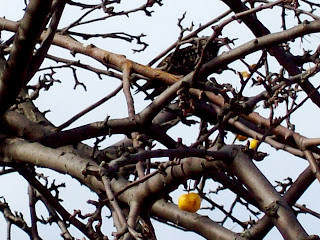On the Wing #36: More Than a Murmuration
They're hard to miss at this time of year. They stream in like blackened snowflakes from the skies above, their forms resembling the sleekest of fighter jets, while remaining in a tight, undulating flock with a flight path about as predictable as the course of water over new ground. I am, of course, referring to the European Starling (Sturnus vulgaris) that flock together when the winter months beckon and swear to freeze every single bird to their perch! I see them a lot these days when I'm sitting at work and on the way to and from many a town nearby, but their ubiquitous nature and presence in our modern America doesn't mean they were always here or should have been in the first place.
Thanks to a man named Eugene Schieffelin and several other members of a band of European Shakespeare aficionados, the dream of bringing a bird mentioned once in King Henry IV, Pt. 1 as well as all the other birds associated with his exemplary works. As such we, the people, have to suffer with these bot flies upon our native ground. Or do we?
To gaze upon the speckled patterns displayed by the adults in the winter as they stalk and scamper through our parks and gardens is a joy to some and they are fed with vigor by many in our community. Even when we don't actively feed them, our plantations do it for us, whether they bring ire or not. The starling in the crab apple pictured above picked about the branches for buds, bugs, and perhaps the apples themselves, if it weren't for most of them being larger than their gullets could handle. Even if we openly despise them and wish them to be gone, even though in small moments like these, can we really remain angry at such fleeting murmurations?
I say yes of course! They may be cute and all, but they're still aggressive and destructive! But then again, aren't all successful species that way. Just some food for thought. Have a happy week and as always, happy birding ^_^
Thanks to a man named Eugene Schieffelin and several other members of a band of European Shakespeare aficionados, the dream of bringing a bird mentioned once in King Henry IV, Pt. 1 as well as all the other birds associated with his exemplary works. As such we, the people, have to suffer with these bot flies upon our native ground. Or do we?
To gaze upon the speckled patterns displayed by the adults in the winter as they stalk and scamper through our parks and gardens is a joy to some and they are fed with vigor by many in our community. Even when we don't actively feed them, our plantations do it for us, whether they bring ire or not. The starling in the crab apple pictured above picked about the branches for buds, bugs, and perhaps the apples themselves, if it weren't for most of them being larger than their gullets could handle. Even if we openly despise them and wish them to be gone, even though in small moments like these, can we really remain angry at such fleeting murmurations?
I say yes of course! They may be cute and all, but they're still aggressive and destructive! But then again, aren't all successful species that way. Just some food for thought. Have a happy week and as always, happy birding ^_^






an invasive species is just that...invasive. Whether they are pretty or not they are harmful to the native environment.
ReplyDelete